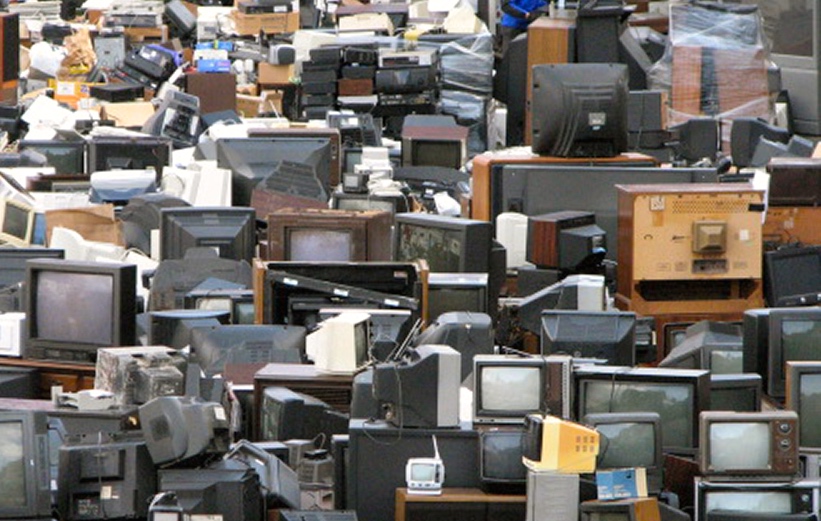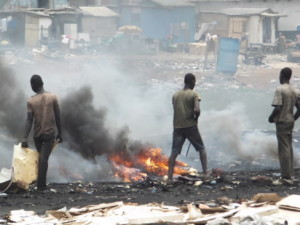The (il)legal trade in e-waste between Europe and West-Africa

By Lieselot Bisschop
Contemporary society generates ever higher quantities of waste as a result of increased consumption and production. The use of chemicals in manufacturing products has also contributed to a higher toxicity of waste (Pellow, 2007). E-waste – waste from electronic and electrical equipment is one of the waste streams that is very prominent. An estimated 72 billion tons of e-waste is expected to be discarded each year by 2017.
The changed quantity and quality of waste has made it into an important commodity, with high costs for environmentally sound treatment and disposal. The deliberate transportation of hazardous waste to countries that do not have the necessary processing facilities is a major form of environmental crime.
Data about the trade in (hazardous) waste and waste generation are incomplete, but an estimated 20 percent of containers exported from the EU contain waste and an estimated 20 percent of those are in violation of export bans or administrative requirements such as missing or incomplete forms for waste trading (Baker et al., 2004).
E-waste contains lead, cadmium, bromium, arsenic, lithium, PCBs, etc. Substandard treatment and disposal of these toxic substances means that they will stay in the environment for many years, absorbed in the air, water and soil. This harm often stays unnoticed harming the ecosystem, animals as well as people living and working nearby.

The trade in hazardous waste is one of the most regulated (e.g. Basel Convention on the Transboundary Movement of Hazardous Waste and its Disposal and the European Union Waste Shipment Regulation) but several governance challenges remain. A first challenge is the criminogenic nature of waste as a product. It can be fairly easily disguised by mixing it up or selling it as second hand commodities (Gibbs et al., 2010). The search for cheaper ways to treat and/or dispose of waste is an important motivator for illegal trade. A second challenge is the criminogenic nature of the waste sector with high complexity and competition. As a consequence, the transition from legal to illegal can occur at several stages of the waste process. This can happen in national and cross-border transport but also in collection or disposal. A third challenge is in the regulatory framework and its implementation. The Basel Convention, as well as EU waste legislation, relies on individual member states’ willingness and resources to implement them. Only limited government resources are invested in controlling for the illegal trade in hazardous waste. Quite often the responsibility for governing the waste trade is split up between different agencies such as police, customs and environmental inspectorates or administrations who each have their own priorities, responsibilities and working methods. Investigating waste fraud requires technical expertise, which is often present only with a limited number of people. Fines that are imposed for waste fraud are often perceived as too low to be effective and become part of shippers’ business plans. Although it is often possible to prove one shipment is illegal, it may be hard to prove this has happened systematically.
The scale of global waste trade makes it very challenging to rely only on governments to take initiatives in controlling and preventing illegal trade. Preventing environmental harm as a consequence of waste trade can be a responsibility of corporations and non-government organizations, next to governments. For instance, positive and negative incentives for corporate actors can be developed so that they can get involved in avoiding harm as a consequence of waste fraud. Producers can ensure less harmful recycling by phasing out hazardous components. Consumers could be more aware of unsustainable consumption in electronics. The lack of raw materials for instance serves as an incentive for recycling corporations to get involved. Transport actors could also be encouraged to be more transparent, in this way avoiding their vessel or company names being shamed for waste fraud. NGOs are crucial for capacity-building projects to engage local actors, for instance the informal waste workers in countries of destination who rely on informal waste dismantling activities as a sole source of livelihood (e.g. e-waste or ship breaking). Governance initiatives to improve environmental legislation and implementation are then paired with projects that impact education, health care and the economy of developing countries in order for them to have the economic, cultural as well as knowledge capital to refuse hazardous waste shipments. However, developing countries also generate their own (hazardous) waste (plastics, obsolete electronics, etc.), either in industrial processes or through consumption. The quantities of domestic waste generation might soon exceed those of industrialized countries. Therefore, it might be more important to think about how to avoid (environmental) harm by substandard dismantling and disposal and not just about how to avoid the illegal trade in e-waste.
This case study about the trade in e-waste is discussed in detail in the author’s book: Bisschop, L. (2015). Governance of the Illegal Trade in E-Waste and Tropical Timber: Case Studies on Transnational Environmental Crime. Green Criminology Series, Ashgate Publishing. (ISBN 978-1-4724-1540-0).
A version of this blog post was published in the most recent issue of Scottish Justice Matters: Bisschop, L. (2015). Challenges in governing the international trade in hazardous waste. Scottish Justice Matters, 3(1) Environmental Crime and Justice, 30-32.